Skunks are notoriously stinky little mammals. These creatures are best known for their ability to spray an extremely smelly liquid when threatened. Skunks come in a variety of shapes, sizes, and colors.
Scientists have identified 10 different skunk species across North, Central, and South America. Some are the classic black and white striped, while others are brown, cream, or reddish in color. Read on to learn about the skunk.
Description of the Skunk
The different skunk species range in size, but they are all small-medium sized mammals. The smallest adults are a little over one foot long, and the largest are up to three feet long including their tails. All species have short legs, long bodies, and a relatively stout build. Because they are fond of digging, their front legs are muscular, and their claws are long and sharp.
Interesting Facts About the Skunk
These creatures get a bad reputation, but they are intelligent animals with lots of interesting traits and adaptations. Learn more about what makes skunks so interesting below.
- Buggy Business – Skunks are omnivores, and feed on a variety of small mammals, eggs, reptiles, fruits, grasses, wasps, and bees. They also eat carrion, and often search for garbage and pet food around people’s homes. Bees and wasps are some of their favorite foods, and they use their strong sense of smell to find nests.
- Sightless – Though they have a great sense of smell, skunks have extremely poor eyesight. They cannot see objects that are farther than 10 ft. away from them. Unfortunately, this makes them susceptible to being hit by cars. Especially in areas with food litter near the road.
- Warning Coloration – All species of skunks have a defensive pattern called warning coloration. Warning coloration is the color or pattern of an animal warns other creatures that they are dangerous in some way. In skunks, the contrasting light and dark colors, and the stripes, means “don’t mess with me!”
- Stinky Defenses – The famous smelly defense strategy of the skunk is to spray an assailant with foul-smelling liquid. This fluid is a combination of chemicals from the anal glands, which can squirt towards adversaries up to 10 feet away. The spray is so potent that is can even deter brown and black bears!
Habitat of the Skunk
The different skunk species will occupy a wide range of habitats. Some are more particular than others, and specialize in a specific habitat. Some frequently occupied habitats are forests, mixed woodlands, rocky outcrops, scrubland, agricultural areas, and even urban areas. There are many different habitats across the range of the different species, and each species has their own preferences.
Distribution of the Skunk
The distribution of each skunk species is different. As a whole, the various species range from North America all the way to South America. Different species of skunks can reside in Canada, the United States, throughout Central America, and various areas of South America. Different species also range throughout Chile, Argentina, Paraguay, Bolivia, Peru, Venezuela, Columbia, and more.
Diet of the Skunk
All of the 10 skunk species are omnivores, which means that they eat both plants and animals. Specific diet varies by species, season, and by region. Insects make up an important of the diet, as wells as worms and larvae.
They also feed on reptiles, amphibians, birds, small mammals, eggs, and other small creatures. Some of the plant matter that they eat includes roots, grasses, nuts, mushrooms, berries, seeds, leaves, and fruits.
Skunk and Human Interaction
Humans tend to avoid skunks when at all possible, and for obvious – and stinky – reasons. However, this does not mean that we do not impact the lives and populations of these creatures. Cars run over skunks, domestic dogs attack them, and their habitats disappear as human populations expand.
Habitat destruction poses a risk to all animals in an area, including skunks. The degree of human impact varies by species. All but two species are not in danger of extinction. Both the pygmy spotted skunk and the eastern spotted skunk have vulnerable populations.
Domestication
Humans have not domesticated skunks in any way.
Does the Skunk Make a Good Pet
People sometimes keep skunks as pets, but in many places it is illegal to own a pet skunk. Humans surgically remove the scent glands of skunks bred as pets. Regardless, they do not lose all their smell, and can still be quite stinky. Skunks require more care than your average dog or cat, and it is important to do your research before considering purchasing one.
Skunk Care
In a zoological or pet setting, the primary concerns should be proper nutrition, exercise, and mental stimulation. A veterinarian should supervise their diet, and recommend the ratio of vegetation to protein, and appropriate protein sources.
Skunks also need plenty of space for exercise and exploration, as they can grow overweight in human care. A wide variety of environmental enrichment, like toys, new scents, and puzzle feeders, keep the skunks entertained and stimulated.
Behavior of the Skunk
Though all species are slightly different, most skunks are solitary in nature. They will congregate in communal dens during particularly cold winters, but usually range throughout their habitat alone.
These creatures are most active in the early morning and late evening, making them crepuscular. During the day, they will sleep underground. Skunks use their strong claws to dig burrows to hide in, but do not truly hibernate in them. Instead, during the winter they are dominant for periods, but will emerge to feed once in a while.
Reproduction of the Skunk
Males have larger territories than females, and they will mate with any females within their range. After breeding, the female digs herself a den to give birth in after a gestation period of approximately two months.
Each litter has between four and seven baby skunks, called kits. The mother weans the kits off of her milk at around two months old, but they remain with their mother until they start families of their own at about a year old.


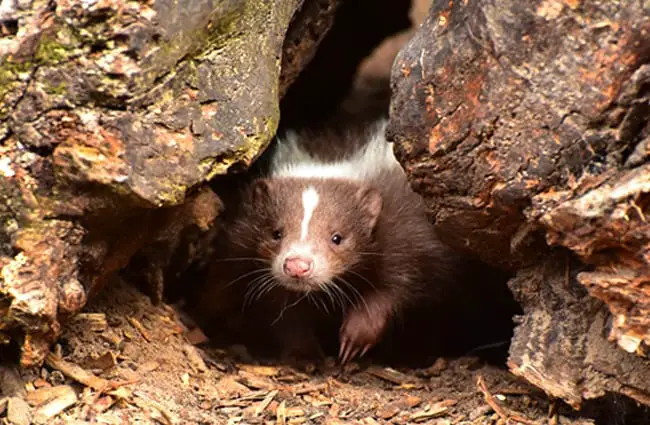

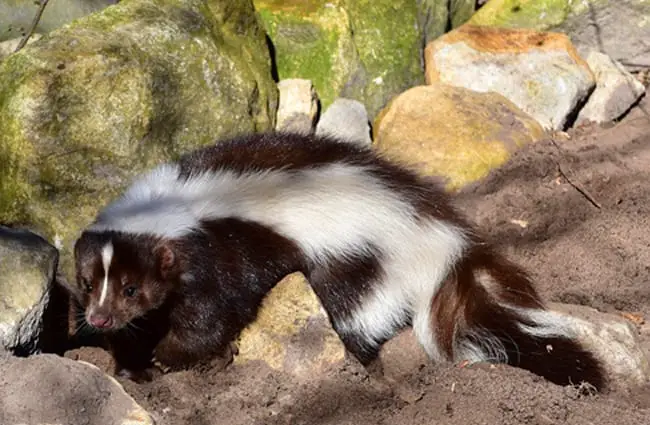
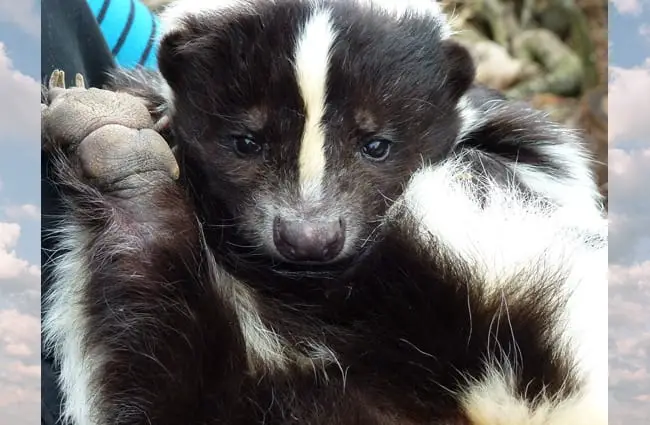
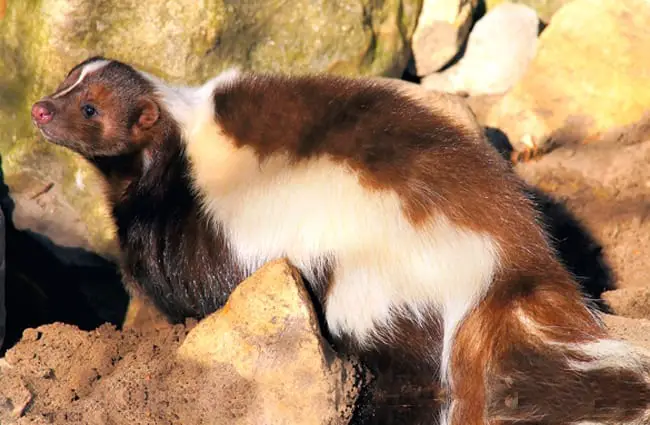
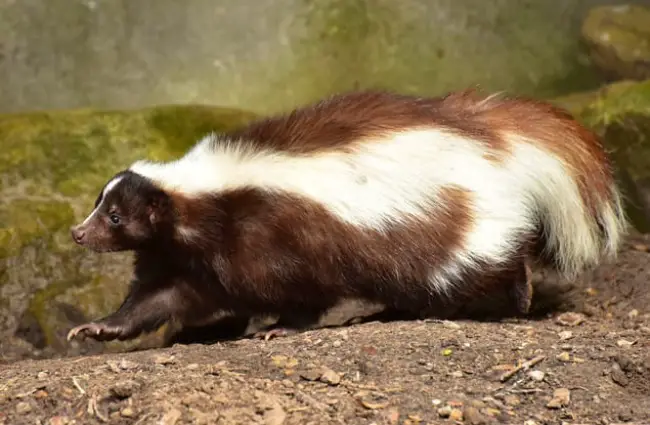



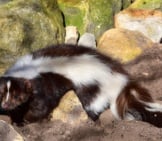
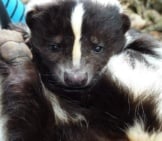


![Red Angus Closeup of a beautiful Red Angus cowPhoto by: U.S. Department of Agriculture [pubic domain]https://creativecommons.org/licenses/by/2.0/](https://animals.net/wp-content/uploads/2020/03/Red-Angus-4-238x178.jpg)


![Red Angus Closeup of a beautiful Red Angus cowPhoto by: U.S. Department of Agriculture [pubic domain]https://creativecommons.org/licenses/by/2.0/](https://animals.net/wp-content/uploads/2020/03/Red-Angus-4-100x75.jpg)

